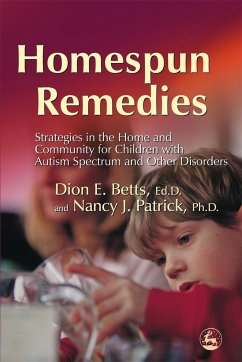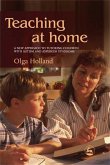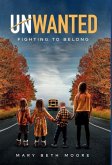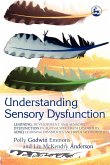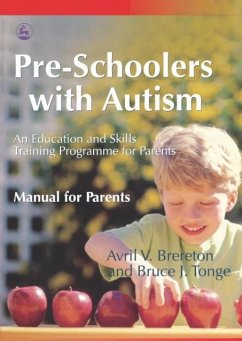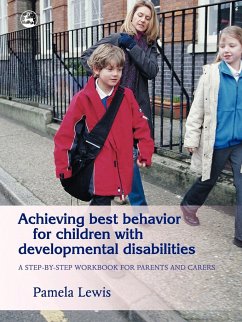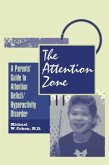Dion Betts, Nancy J Patrick
Homespun Remedies
Strategies in the Home and Community for Children with Autism Spectrum and Other Disorders
Schade – dieser Artikel ist leider ausverkauft. Sobald wir wissen, ob und wann der Artikel wieder verfügbar ist, informieren wir Sie an dieser Stelle.
Dion Betts, Nancy J Patrick
Homespun Remedies
Strategies in the Home and Community for Children with Autism Spectrum and Other Disorders
- Broschiertes Buch
Andere Kunden interessierten sich auch für
![Teaching at Home Teaching at Home]() Olga HollandTeaching at Home27,99 €
Olga HollandTeaching at Home27,99 €![Unwanted: Fighting to Belong Unwanted: Fighting to Belong]() Mary Beth MooreUnwanted: Fighting to Belong23,99 €
Mary Beth MooreUnwanted: Fighting to Belong23,99 €![Understanding Sensory Dysfunction Understanding Sensory Dysfunction]() Polly Godwin EmmonsUnderstanding Sensory Dysfunction23,99 €
Polly Godwin EmmonsUnderstanding Sensory Dysfunction23,99 €![Pre-Schoolers with Autism Pre-Schoolers with Autism]() Avril V. BreretonPre-Schoolers with Autism29,99 €
Avril V. BreretonPre-Schoolers with Autism29,99 €![Achieving Best Behavior for Children with Developmental Disabilities Achieving Best Behavior for Children with Developmental Disabilities]() Pamela LewisAchieving Best Behavior for Children with Developmental Disabilities27,99 €
Pamela LewisAchieving Best Behavior for Children with Developmental Disabilities27,99 €![The Attention Zone The Attention Zone]() Michael CohenThe Attention Zone63,99 €
Michael CohenThe Attention Zone63,99 €
Produktdetails
- Verlag: Jessica Kingsley Publishers
- Seitenzahl: 160
- Erscheinungstermin: 1. April 2006
- Englisch
- Abmessung: 232mm x 161mm x 11mm
- Gewicht: 254g
- ISBN-13: 9781843108139
- ISBN-10: 1843108135
- Artikelnr.: 22375858
- Herstellerkennzeichnung
- Libri GmbH
- Europaallee 1
- 36244 Bad Hersfeld
- gpsr@libri.de
Dion E. Betts is a special education administrator, adjunct professor, writer, and presenter. He and his wife have five children, one of whom has AS. They live in Lancaster, Pennsylvania. Nancy J. Patrick is assistant professor of special education at Messiah College, Grantham, Pennsylvania. She is an author, teacher, writer, and presenter. She lives near Harrisburg, Pennsylvania, with her husband and their three children, one of whom has a disability.
A note on the book. Introduction: What is So Special about Children with
Autism Spectrum Disorders? 1. Home Life. Babysitters. Bees. Breastfeeding.
Discipline. Dogs. Finances. Food. Friendships. Holidays. Marriage issues.
Mealtimes. Morning and nighttime routines. Noise. Organization.
Preferences. Respite care. Restaurants. Siblings and other relatives.
Support groups. Talking about disabilities. Tantrums. Telephone skills.
Textures and temperatures. Weather. 2. Hygiene. Bath time. Brushing teeth.
Clothes. Grooming. Hair cuts. Nail clipping. Toilet training. 3. Community.
Airplanes. Birthday parties. Car travel. Hotels and vacations. Play dates.
Shopping. Shoe stores. Swimming pools. Visiting other families. 4. Medical.
Dentist and doctor visits. Emergencies. Emergency phone calls.
Immunizations. Medications. 5. Schools and Organizations Breaks. Bus rides.
Clubs. Evaluations. Hobbies. Homework. Mental health agencies. Religious
services. Report cards. School lunches. School team meetings. Sports:
Hallie's story. Sports: John's story. Teacher assistants. Therapists.
Valentine's Day. 6. Tools for Adapting the Environment for Success.
Behavior plans. Choice boards. Direct instruction. First-then statement
cards. Macro and micro schedules. Role-playing. Scripting. Symbol
communication systems. Task analysis. Wait boxes. Conclusion. References.
Autism Spectrum Disorders? 1. Home Life. Babysitters. Bees. Breastfeeding.
Discipline. Dogs. Finances. Food. Friendships. Holidays. Marriage issues.
Mealtimes. Morning and nighttime routines. Noise. Organization.
Preferences. Respite care. Restaurants. Siblings and other relatives.
Support groups. Talking about disabilities. Tantrums. Telephone skills.
Textures and temperatures. Weather. 2. Hygiene. Bath time. Brushing teeth.
Clothes. Grooming. Hair cuts. Nail clipping. Toilet training. 3. Community.
Airplanes. Birthday parties. Car travel. Hotels and vacations. Play dates.
Shopping. Shoe stores. Swimming pools. Visiting other families. 4. Medical.
Dentist and doctor visits. Emergencies. Emergency phone calls.
Immunizations. Medications. 5. Schools and Organizations Breaks. Bus rides.
Clubs. Evaluations. Hobbies. Homework. Mental health agencies. Religious
services. Report cards. School lunches. School team meetings. Sports:
Hallie's story. Sports: John's story. Teacher assistants. Therapists.
Valentine's Day. 6. Tools for Adapting the Environment for Success.
Behavior plans. Choice boards. Direct instruction. First-then statement
cards. Macro and micro schedules. Role-playing. Scripting. Symbol
communication systems. Task analysis. Wait boxes. Conclusion. References.
A note on the book. Introduction: What is So Special about Children with
Autism Spectrum Disorders? 1. Home Life. Babysitters. Bees. Breastfeeding.
Discipline. Dogs. Finances. Food. Friendships. Holidays. Marriage issues.
Mealtimes. Morning and nighttime routines. Noise. Organization.
Preferences. Respite care. Restaurants. Siblings and other relatives.
Support groups. Talking about disabilities. Tantrums. Telephone skills.
Textures and temperatures. Weather. 2. Hygiene. Bath time. Brushing teeth.
Clothes. Grooming. Hair cuts. Nail clipping. Toilet training. 3. Community.
Airplanes. Birthday parties. Car travel. Hotels and vacations. Play dates.
Shopping. Shoe stores. Swimming pools. Visiting other families. 4. Medical.
Dentist and doctor visits. Emergencies. Emergency phone calls.
Immunizations. Medications. 5. Schools and Organizations Breaks. Bus rides.
Clubs. Evaluations. Hobbies. Homework. Mental health agencies. Religious
services. Report cards. School lunches. School team meetings. Sports:
Hallie's story. Sports: John's story. Teacher assistants. Therapists.
Valentine's Day. 6. Tools for Adapting the Environment for Success.
Behavior plans. Choice boards. Direct instruction. First-then statement
cards. Macro and micro schedules. Role-playing. Scripting. Symbol
communication systems. Task analysis. Wait boxes. Conclusion. References.
Autism Spectrum Disorders? 1. Home Life. Babysitters. Bees. Breastfeeding.
Discipline. Dogs. Finances. Food. Friendships. Holidays. Marriage issues.
Mealtimes. Morning and nighttime routines. Noise. Organization.
Preferences. Respite care. Restaurants. Siblings and other relatives.
Support groups. Talking about disabilities. Tantrums. Telephone skills.
Textures and temperatures. Weather. 2. Hygiene. Bath time. Brushing teeth.
Clothes. Grooming. Hair cuts. Nail clipping. Toilet training. 3. Community.
Airplanes. Birthday parties. Car travel. Hotels and vacations. Play dates.
Shopping. Shoe stores. Swimming pools. Visiting other families. 4. Medical.
Dentist and doctor visits. Emergencies. Emergency phone calls.
Immunizations. Medications. 5. Schools and Organizations Breaks. Bus rides.
Clubs. Evaluations. Hobbies. Homework. Mental health agencies. Religious
services. Report cards. School lunches. School team meetings. Sports:
Hallie's story. Sports: John's story. Teacher assistants. Therapists.
Valentine's Day. 6. Tools for Adapting the Environment for Success.
Behavior plans. Choice boards. Direct instruction. First-then statement
cards. Macro and micro schedules. Role-playing. Scripting. Symbol
communication systems. Task analysis. Wait boxes. Conclusion. References.

